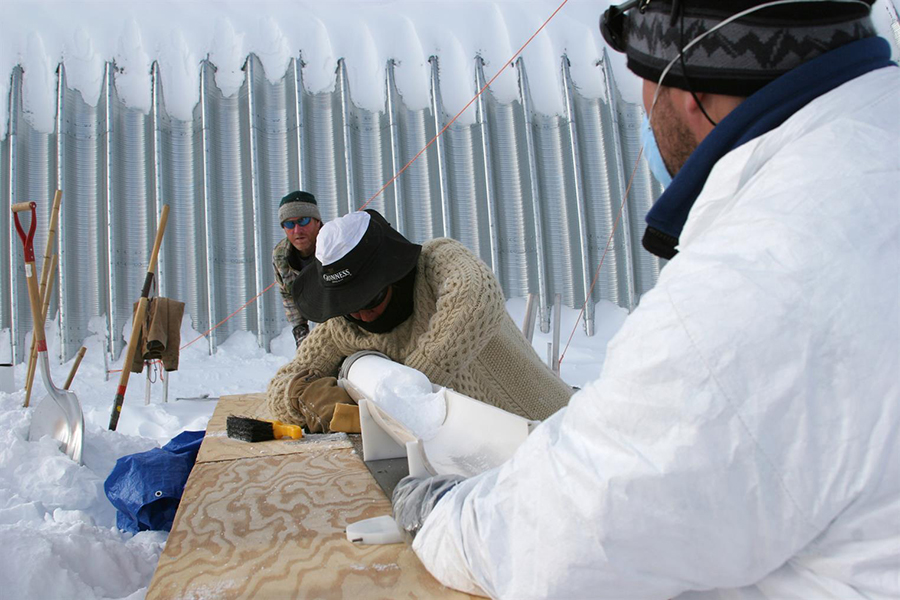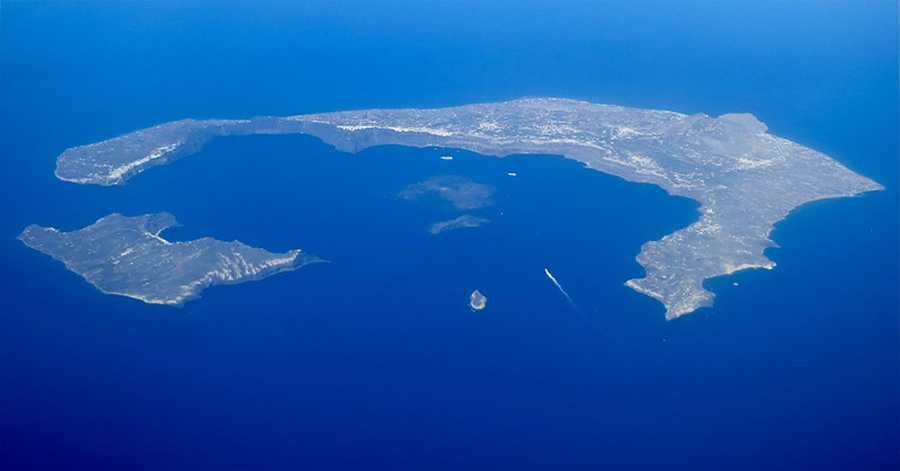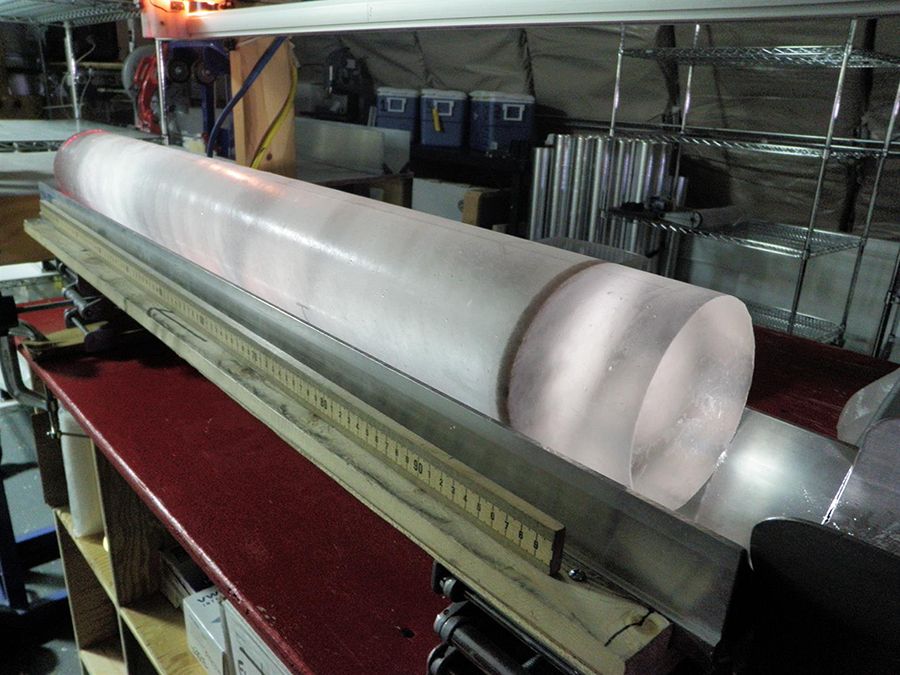Ice core tells 11,000-year history of explosive volcanic eruptionsFirst-of-its-kind record sheds light on ancient eruptions and climate conditionsPosted June 30, 2021
An ice core from West Antarctica is giving scientists insight into some intriguing climate anomalies of ages past and deepening the mystery of a volcanic eruption that destroyed a Greek island some 3,600 years ago. Scientists studying an ice core drilled at the West Antarctic Ice Sheet Divide, or WAIS Divide, are using volcanic ash deposits embedded within the layers of ice to tally the number of explosive volcanic eruptions that occurred over the past 11,000 years and to pin down exactly when those eruptions happened. The researchers counted deposits from 426 large eruptions during the 11,000-year period that occurred in the Southern Hemisphere and in the Northern Hemisphere near the equator. Analyzing the deposits will shed light on how clouds of ash and gas from volcanic eruptions travel through the atmosphere and affect Earth’s climate. Explosive eruptions, like the one at Mount Saint Helens in 1980, spew hot ash and gas into the atmosphere that block or reflect sunlight, typically causing temperatures to drop. Studying the deposits from these eruptions will help researchers better understand how Earth’s climate has varied throughout the Holocene, the modern period since the most recent ice age ended roughly 11,000 years ago. “Ice cores happen to be one of the best ways we can get a very good handle on both the records of past eruptions and how the climate interacts with that or responds to that,” said Jihong Cole-Dai, an atmospheric chemist at South Dakota State University and lead author of a new study detailing the findings. “That was one of the goals of the WAIS Divide project.” Explosive evidenceThe WAIS Divide ice core comes from an ice divide in the West Antarctic Ice Sheet, an area where ice on one side of the divide flows toward the ocean in one direction and ice on the other side flows in a different direction – similar to how a continental divide delineates how rivers flow in different directions. 
Photo Credit: Steven Profaizer
Scientist Joe Souney, right, receives a section of the WAIS Divide ice core as it is freed from the drill by Bella Bergeron and Mike Jayred.
Scientists chose the WAIS Divide site for ice coring because, unlike most of the continent, enough snow falls there that it’s possible to see each individual year’s snowfall compressed as a layer of ice for at least the past 30,000 years. The project began in the 2000s and, while drilling finished in 2011, scientists continue to analyze the core and learn from it. In the new study, Cole-Dai and his colleagues searched the WAIS Divide ice core for evidence of explosive volcanic eruptions over the past 11,000 years. They looked for layers of sulfuric acid – a chemical byproduct of volcanic explosions – throughout the column of ice. They also analyzed the chemical content of the ice and the air bubbles trapped within each ice layer to see how Earth’s climate varied from year to year during this period. The researchers found evidence of 426 large eruptions over the last 11 millennia and pinpointed the year when each of those eruptions happened. Scientists had previously thought the most recent two thousand years were more volcanically active than earlier parts of the Holocene, but the new results show that is not the case – the past two millennia were actually quite average. “There's really no difference between what's happening now in the recent past versus what happened in the earlier part of the Holocene,” Cole-Dai said. The results are helping climate scientists better understand a mysterious cool period that occurred around 8,000 years ago. During the 8.2k event, as it’s called, Earth’s climate cooled considerably for several hundred years during a time when scientists expected it to have been warm. One of the theories for why this cooling event happened was a pulse of freshwater into the North Atlantic from the last vestiges of the Laurentide Ice Sheet in North America. But did volcanic ash from eruptions, which block out sunlight, also play a part in the cooling? Until now, researchers hadn’t been able to nail down any major eruptions that could be responsible. But Cole-Dai and his colleagues spotted several large eruptions right before and during that period in the WAIS Divide ice core. “Because we know volcanic eruptions can cause short-term cooling, it is possible that these eruptions either helped start the episode or made it colder than it would have been,” he said. The mystery of TheraThe researchers had hoped the new volcanic record would shed some light on an intriguing blast from the Mediterranean region during antiquity, but the WAIS Divide results only deepen the mystery. 
Photo Credit: Steve Jurvetson, CC BY 2.0
This aerial image shows the Greek islands of Santorini (large) and Therasia (small). The islands are remnants of a larger island called Thera that blew apart during the Minoan volcanic eruption.
The Minoan eruption was one of the largest volcanic events in human history. The eruption blew apart the Greek island of Thera (modern-day Santorini), decimated the Minoan civilization living there, and is thought to have caused apocalyptic rainstorms in Egypt. The eruption is an important historical milestone as archaeologists and historians speculate that it completely changed the course of human civilization in the Mediterranean. But it also poses a mystery. No human remains were found on the island, which suggests the residents evacuated ahead of time, but archaeologists can’t figure out where the Minoans escaped to, if they did indeed survive. Knowing when exactly the eruption happened could help scientists and archaeologists solve the mystery, but they have had trouble pinning down its timing. Researchers are currently divided into two camps on the subject – some argue the eruption happened between 1650 and 1600 BCE, while others suspect it occurred later, between 1600 and 1525 BCE. Ice cores from Greenland show evidence of three eruptions that match the earlier time period, but experts can’t say whether those ash deposits came from Thera. Cole-Dai hoped the WAIS Divide ice core might provide new evidence to help with the debate. For an eruption to show up in an Antarctic ice core, it needs to take place either in the Southern Hemisphere or in the Northern Hemisphere near the equator. Ash deposits from a volcano like Thera, located in the Mediterranean, likely wouldn’t reach a spot so near the South Pole. If one of the eruptions found in the Greenland record were missing in WAIS Divide, it’s likely that ash embedded in Greenland ice cores originated from Thera’s mighty explosion. When Cole-Dai and his colleagues zeroed in on the earlier period of Thera’s destruction in the WAIS Divide core, they found ash from all three major eruptions that matched those seen in Greenland. Meaning the ash found in the Greenland ice core couldn’t have been from Thera. “Only a volcano near the equator can spread its aerosols to both hemispheres and show up in both places,” Cole-Dai said. “So our data essentially does not support the idea that [the Greenland ash deposits] were the Thera eruption.” This means scientists must go back to the drawing board to find evidence of Thera’s blowout in geologic records, and presumably, the debate about its timing rages on. The WAIS Divide ice core project was supported by the National Science Foundation, which manages the U.S. Antarctic Program. NSF-funded research in this story: Jihong Cole-Dai, South Dakota State University, Award No. 0538553 and 0612461; Joseph R. McConnell, Desert Research Institute, Award No. 0839093 and 1142166. |
"News about the USAP, the Ice, and the People"



For USAP Participants |
For The Public |
For Researchers and EducatorsContact UsU.S. National Science FoundationOffice of Polar Programs Geosciences Directorate 2415 Eisenhower Avenue, Suite W7100 Alexandria, VA 22314 Sign up for the NSF Office of Polar Programs newsletter and events. Feedback Form |


